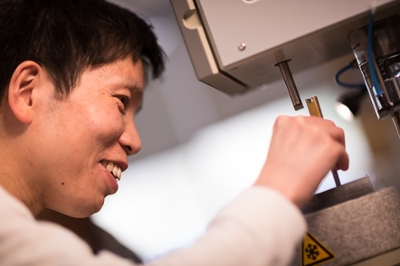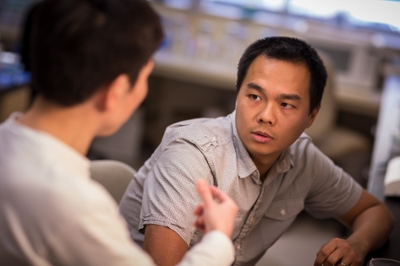The festive image of a protein called PKD2 downplays the serious reason for creating it. Full of twirls and curlicues, the portrait resembles a ruffled hat with ribbons hanging from the edges. Published in October in Cell as part of a study led by scientists at the University of Utah School of Medicine, the structure reveals how specific mistakes in the precisely tousled protein triggers polycystic kidney disease, the most common inherited kidney disorder.
"A picture is worth 1,000 words," says Peter Shen, Ph.D., research assistant professor in the Department of Biochemistry. PKD2 is an ion channel that ferries charged atoms into and out of the cell. "The function of PKD2 is not well understood but seeing what it looks like gives us ideas about how to address that question."
Shen led the study in collaboration with senior author Erhu Cao, Ph.D., assistant professor in the Department of Biochemistry, Cao's postdoctoral fellow Xiaoyong Yang, Ph.D., and researchers at Northwestern University, University of California San Francisco, and Boston Children's Hospital.
 Dubbed the "silent killer", patients with polycystic kidney disease often don't know they have it until they are in their 30s or 40s. And once they know, there's not much that can be done. Cysts form most prominently in the kidneys, causing them to enlarge and eventually fail in about 60 percent of patients.
Dubbed the "silent killer", patients with polycystic kidney disease often don't know they have it until they are in their 30s or 40s. And once they know, there's not much that can be done. Cysts form most prominently in the kidneys, causing them to enlarge and eventually fail in about 60 percent of patients.
Scientists have long recognized that having an accurate visual of PKD2 – one of two proteins that cause the disease when marred by inheritable mutations - could help them understand how the illness arises. But capturing its mug shot has been tough-going. The protein is embedded in an oily membrane and weaves through the inside and outside of the cell, making it difficult to reproduce conditions that mimic its surroundings in the body. Picturing PKD2 in an unnatural state would be like documenting a cowboy at a beauty parlor. The scenario wouldn't offer much insight into what it might be doing normally.
A combination of advances in technology and skill helped Cao and colleagues meet the challenge. In order for the protein to feel at home, the researchers created tiny islands of fat, called lipid nanodiscs, that approximate the cell membrane in which PKD2 normally resides. They then flash-froze and analyzed the mini-assembly using cryo-electron microscopy, distinguishing details close to the resolution of individual atoms. With computational support from the Center for High Performance Computing at the University of Utah, the researchers crunched through terabytes of data to piece it all together.
What they saw explained why the majority of the PKD2 mutations that cause polycystic kidney disease are so dire. Many are at the top of the "hat", the so-called polycystin domain, a previously enigmatic domain that this investigation showed is important for holding the channel together. It also likely senses as-of-yet unidentified chemicals. Another hotspot is a curlicue that extends into the center, the pore helix, important for controlling the opening and closing of the channel.
The researchers surmise that disruptions in either region would cause the protein to fall apart, and cease to function. "Now we have a blueprint to understand the basis for the effect of mutations on disease," says Shen.
The detailed images of PKD2 also revealed some surprises. Its large "hat" makes it distinctly different from the larger protein class it belongs to, a family of 27 transient receptor potential (TRP) ion channels. What's more, originally, researchers though that PKD2 conducted calcium, but in this study collaborator and co-senior author David Clapham, M.D., Ph.D., demonstrated that it is more efficient at transporting sodium and potassium.
This information is helping scientists gain a better understanding of how the channel works, but there is much more to learn. "Our next steps are to search for pharmacological agents that activate, or block, PKD2," says Cao. "That would help in designing drugs to manage the disease."
###
This work was supported by the National Institutes of Health (Cao) and the Howard Hughes Medical Institute (Clapham).
"The Structure of the Polycistic Kidney Disease Channel PKD2 in Lipid Nanodiscs" by Peter Shen, Xiaoyong Yang, Paul DaCaen, Xiaowen Liu, David Bulkey, David Clapham, and Erhu Cao was published online in Cell on October 20, 2016.